CEFR Japanese Course
Japanese Language Education Program
Are you looking to provide Japanese language education for foreign students or employees?
We offer Japanese language education programs tailored to schools and companies.
Do you have concerns about Japanese language education for foreign employees or students?
For companies with foreign employees
- Employees lack the required Japanese language proficiency.
- Employees struggle with differences in lifestyle and culture.
- Employees find it difficult to understand Japanese manuals.

For schools with foreign students
- Want to provide Japanese instruction more conveniently.
- Do not have enough resources to allocate to Japanese instruction.
- Lack experience in teaching Japanese as a second language and are unsure about teaching methods.
- Have difficulty securing instructors for teaching.

Features of Japanese language courses for foreign students and employees
Features of the CEFR Japanese program for companies
- Fully online, so you can study Japanese from anywhere with just one computer!
- Flexible curriculum and schedule, enabling your employees to acquire N3 and N2 Japanese language skills.
- Students can learn Japanese before coming to Japan and can continue to study even after arriving in Japan.
- A company's administrator can keep track of the student's current level of proficiency and attendance.
- Nisai will become a member of your company or school's Japanese language instructor team.
- Fully online, so you can participate in the course from multiple locations at once.

Fully online, allowing Japanese learning without location restrictions with just one computer.
Previously, it was common to invite Japanese instructors to conduct training internally or attend training sessions at nearby classrooms. However, with Nisai's system, everything from attending classes to submitting assignments and receiving feedback from teachers can be done with just one computer. With an online environment, learning can take place anywhere, whether at home or on the go, making it convenient for learners.

Flexibility in implementation time and curriculum content, enabling acquisition of N3-N2 Japanese language proficiency.
Nisai can flexibly set curriculums and implementation times tailored to the Japanese proficiency required by learners through consultations with companies. Additionally, experienced instructors conduct classes according to the learners' situations, allowing steady acquisition of N3-N2 level Japanese proficiency.
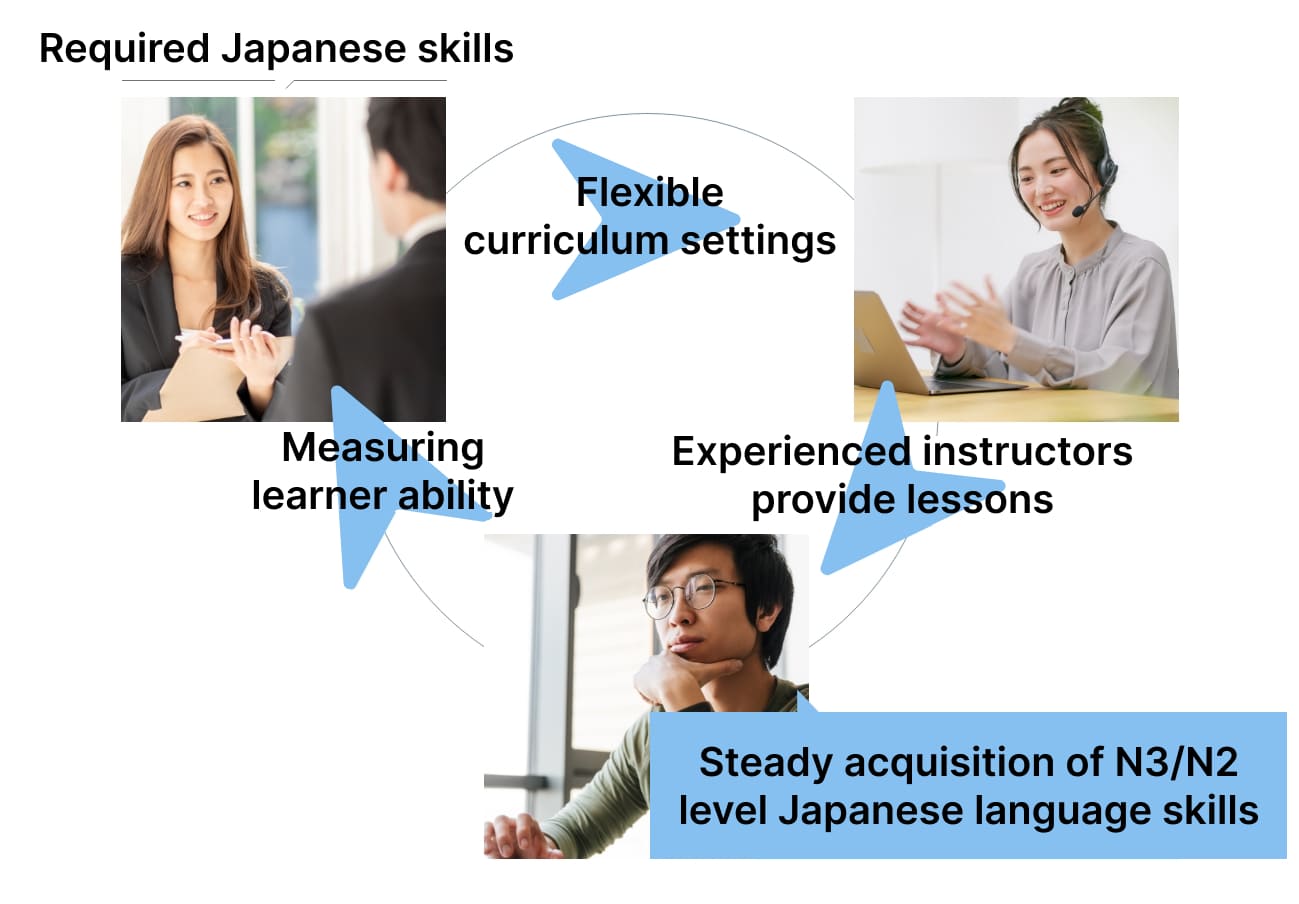
Learners can acquire Japanese language skills before arriving in Japan and continue learning after arrival.
Foreign employees used to come to Japan through local dispatch agencies. Although they received some Japanese training locally, companies often relied on JLPT exam results for hiring decisions. However, there was often a mismatch between the Japanese proficiency level indicated by the JLPT results and the actual proficiency level required for employment. Nisai ensures that learners acquire proficiency before coming to Japan and continues to support their Japanese learning even after arrival.
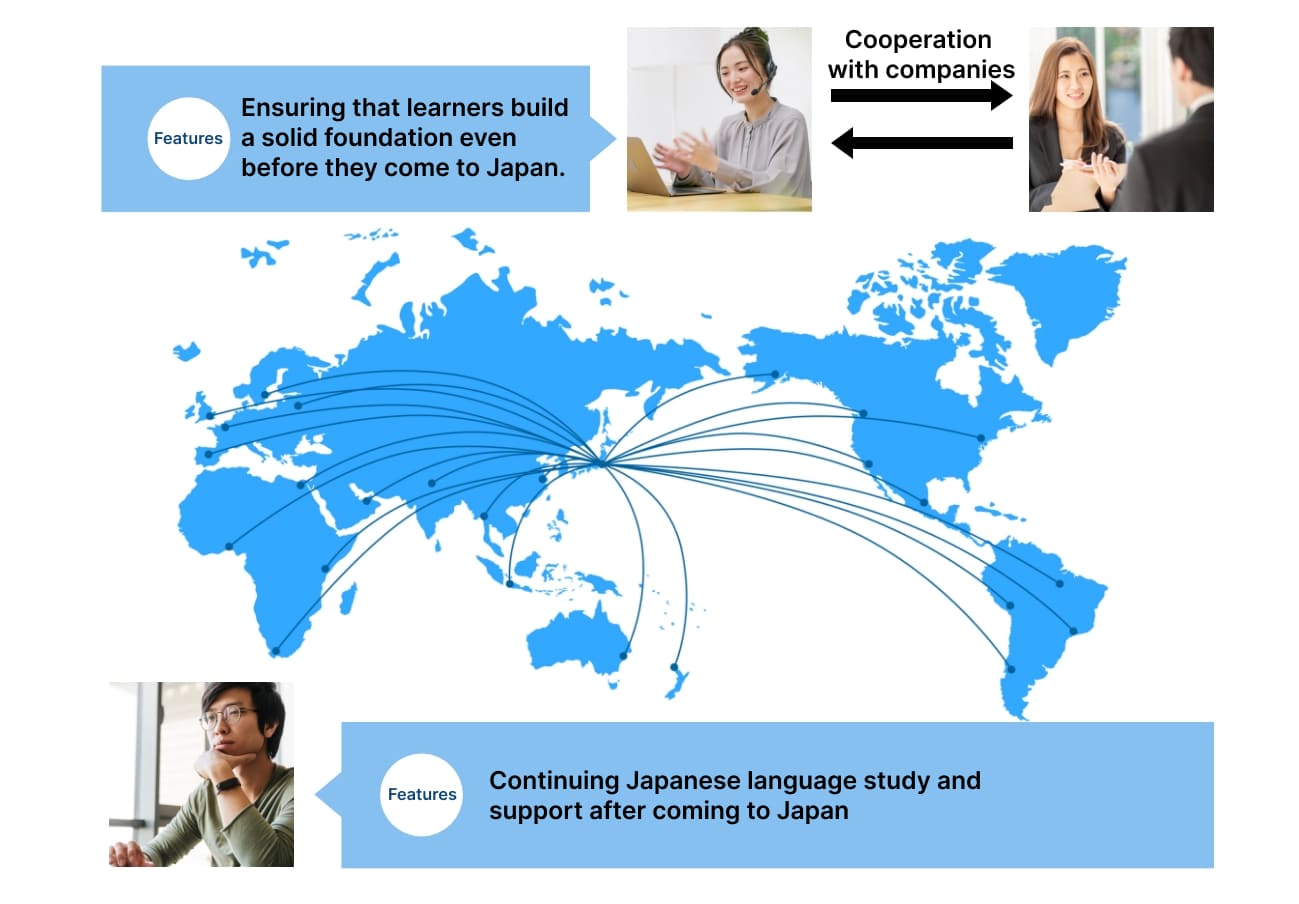
A company's administrator can keep track of the learner's current level of proficiency and attendance rate.
The same is true both before and after the students arrive in Japan, but it was difficult for those in charge at the companies to grasp the learners' Japanese language skills. Also, according to Japanese language instructors, students often doze off during class. However, because Nisai is a fully online school, company representatives can check student attendance and assignments anytime. They can also see feedback from the teachers, so they can devise ways to support their employees.
Instructors can monitor students' assignment status.
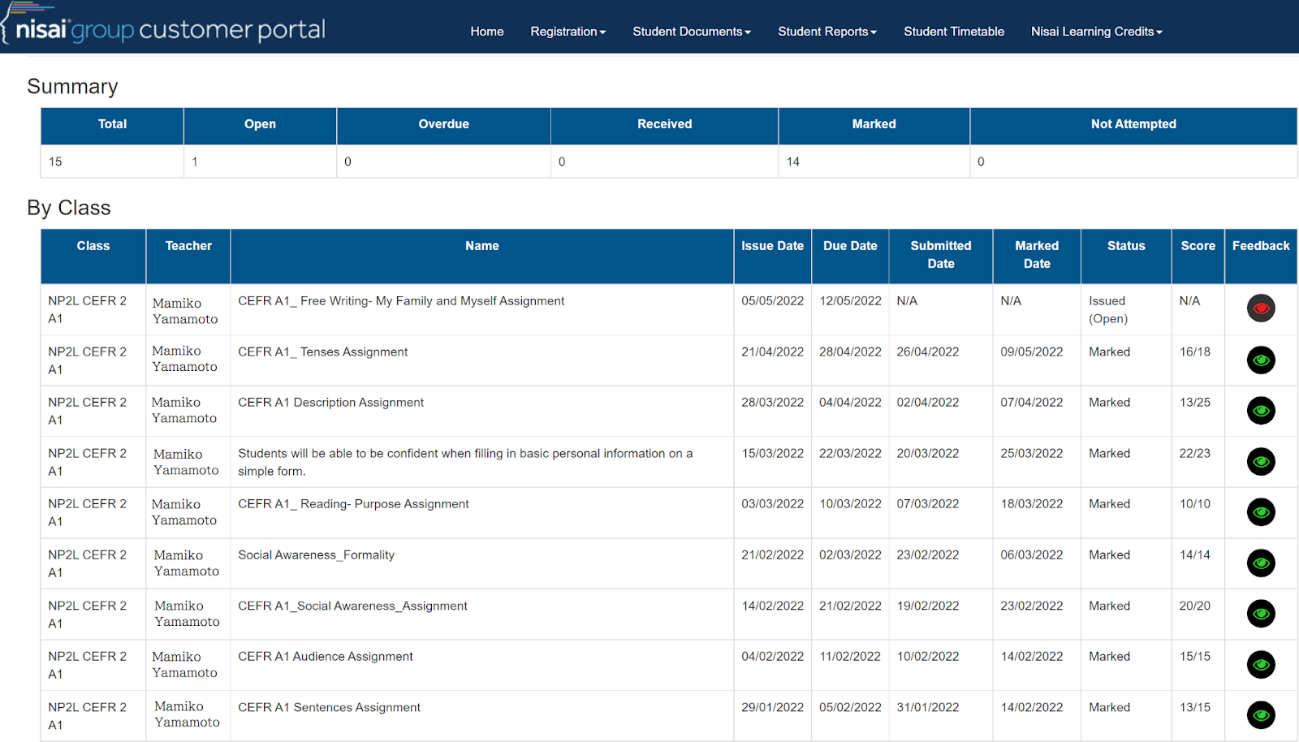
Instructors can also track students' attendance status.
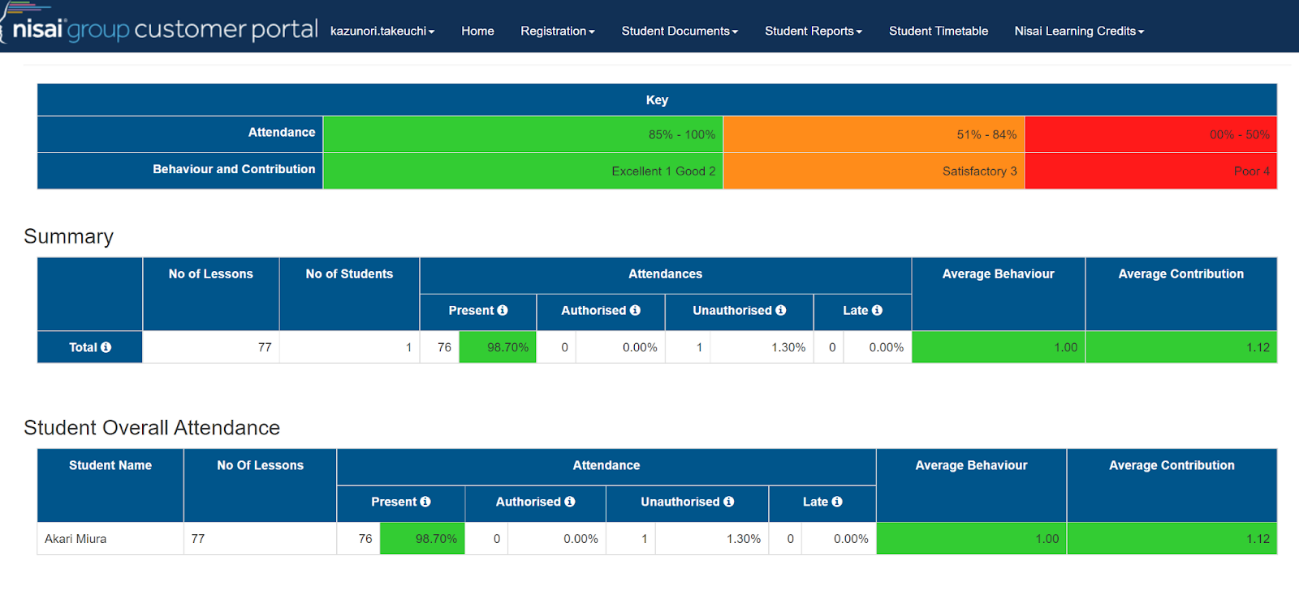
Nisai will become your company's Japanese language instruction team.
Many managers may think, "If they can work and have skills, they don't need to be fluent in Japanese." However, colleagues in the field often face challenges. Language acquisition is essential for conveying skills and facilitating communication through language. However, arranging instructors to teach Japanese and setting aside learning time can be challenging. Additionally, many hiring managers want candidates to have a stronger command of Japanese before employment. Nisai will become your company's Japanese education team, eliminating the need to arrange Japanese language instructors and create learning environments or schedules.

Fully online, allowing simultaneous participation from multiple locations.
Companies with extensive branch networks used to have to arrange training for foreign employees at each location. However, Nisai is an online school, so classrooms are also online. Learners can participate from anywhere, allowing multiple locations to join classes simultaneously. Additionally, communities of foreign employees working for the same company can be formed, enabling them to consult each other about issues and increasing the continuity of work.
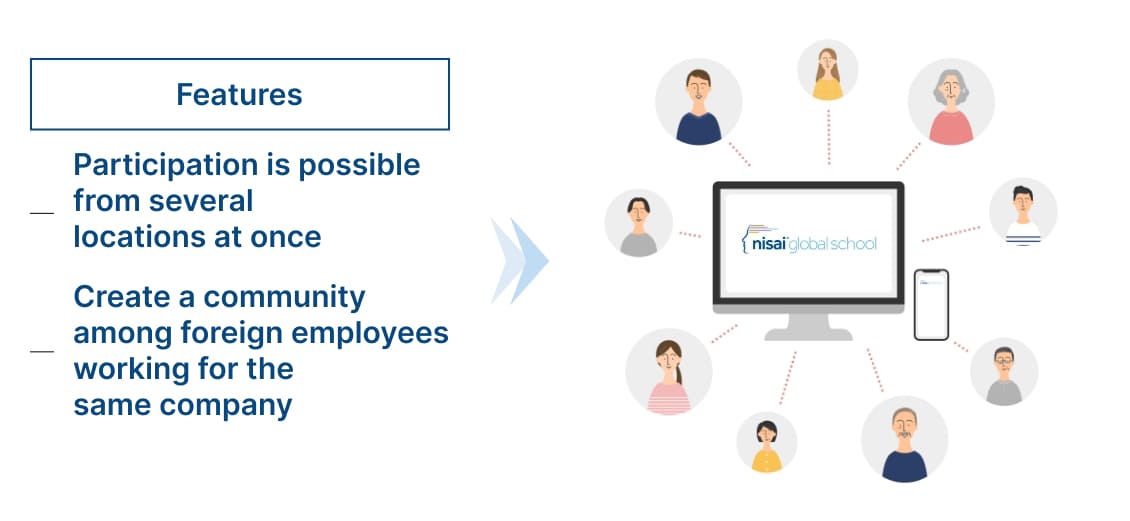
We recommend CEFR courses for Japanese language learning for foreign students and employees. Experienced Nisai (Nisai Virtual Academy) instructors will provide programs for foreign employees who want to learn Japanese for employment or career advancement in Japan, as well as for foreign students of all ages who want to smoothly carry out their daily lives in Japan.Nisai's CEFR courses aim to develop language proficiency in the four skills according to world standards. These courses focus on improving Japanese language skills in listening, reading, writing, and speaking. The content of the learning is based on real situations related to public, personal, educational, and professional topics. Each course is designed to help learners develop the Japanese language proficiency they need.
Nisai's CEFR Japanese courses provide the equivalent of CEFR levels. Learners can acquire proficiency from CEFR A1 level to C2 level (N5 to N1) through Nisai.N3 and N2 Japanese language proficiency is important not only for job hunting in Japan but also for working regardless of experience or occupation. Having N3 or higher proficiency in CEFR Japanese can be a strong asset for job hunting or career advancement. Additionally, many foreigners working for local companies abroad (including Japanese companies) are learning Japanese to communicate within the company. We hope that you will acquire practical Japanese language skills with Nisai's CEFR courses and further your career in Japan by gaining more experience domestically.
Opportunities such as business utilization, career advancement, and employment in Japan expand with Japanese language skills

Having a Japanese language qualification naturally provides an advantage in domestic jobs and enhances one's image. As the recruitment of foreign employees by companies in Japan becomes more active, the demand for business professionals who can speak Japanese is increasing. The hiring rate of foreign employees in companies is also increasing year by year. Therefore, while many companies prioritize skills, there is also a growing trend of wanting employees with a certain level of Japanese proficiency. Therefore, having Japanese language qualifications in the resume makes it more noticeable in job hunting or career changes.
Japanese Language Instruction for Foreign Students Made Easy! Nisai Becomes a Member of Your School's Japanese Education Team
Features of the School-based CEFR Japanese (Japanese Language Education Program)
- Fully online, so you can study Japanese from anywhere with just one computer!
- Flexible hours and curriculum content ensure the steady acquisition of Japanese language skills.
- Continuous learning is possible both at school and at home.
- Our staff can keep track of the students' current level of proficiency and attendance.
- Nisai will become a member of your school's Japanese language instructor team.
- Fully online, so you can participate in the course from multiple locations at once

Perfectly Online, allowing Japanese language learning anywhere with just one computer.
Until now, it has been common to invite Japanese language teachers to schools or to attend separate classes at nearby classrooms to conduct education. However, with Nisai's system, everything from taking courses, submitting assignments, to receiving feedback from teachers can be done with just one computer. Since you can take classes online, you can choose any location. You can easily take classes "anytime, anywhere," whether at home or at school.

Flexible scheduling and curriculum content allow for steady Japanese language acquisition.
At Nisai, we can meet with schools to flexibly set up the curriculum and schedule for Japanese language education according to the needs of students. Additionally, experienced instructors conduct classes tailored to the learners' situations, enabling steady acquisition of Japanese language proficiency.
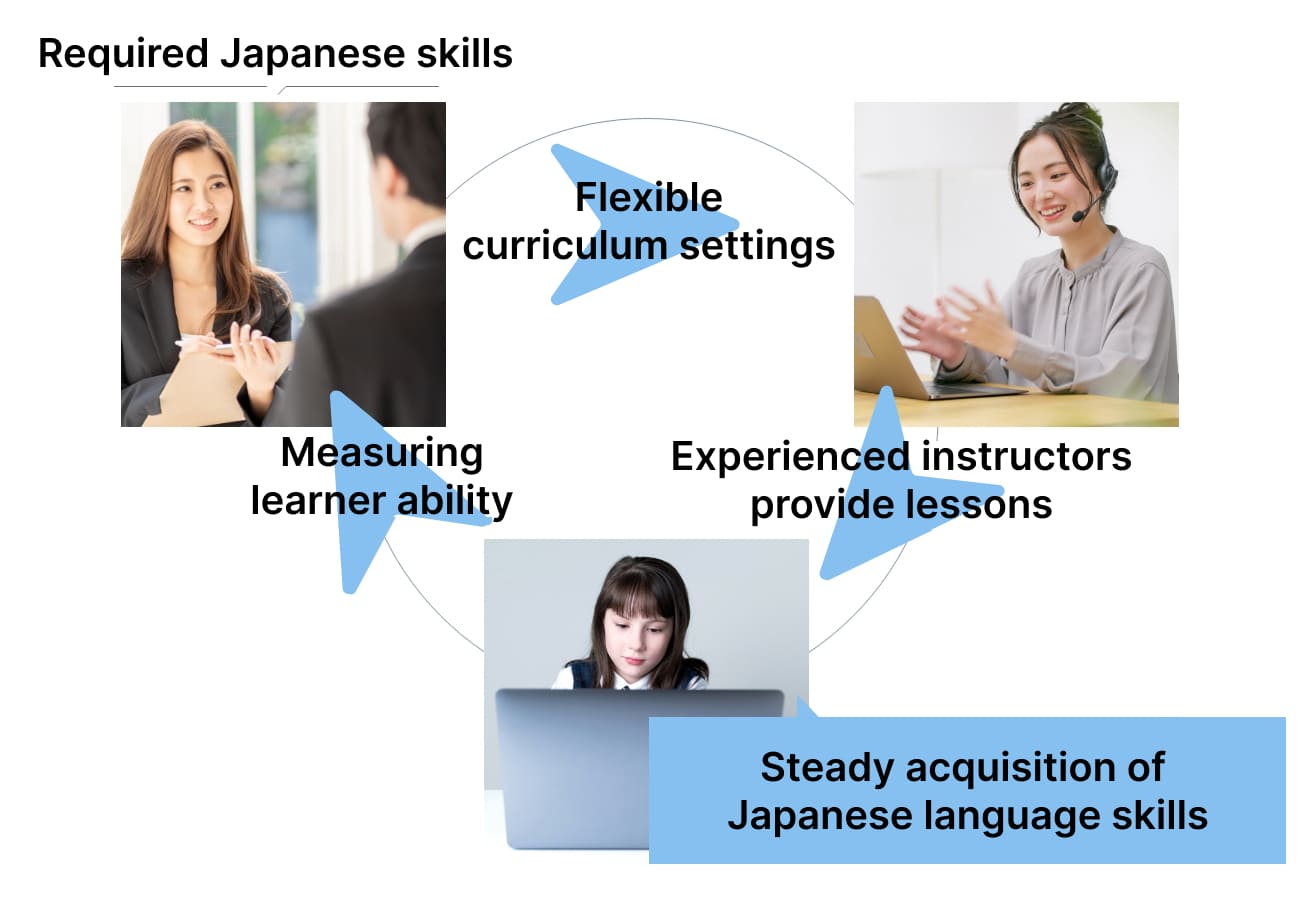
Continuous learning is possible both at school and at home.
While some foreign students can speak Japanese to a certain extent, others may have little understanding. In many schools, classes are conducted in Japanese, so additional individual guidance from homeroom teachers or Japanese language teachers arranged by the board of education, who visit schools a few times a month to provide Japanese language education to students, is common. It's a fact that supporting these students within the school environment can be challenging. Since Nisai is a fully online school, learning can continue from anywhere.
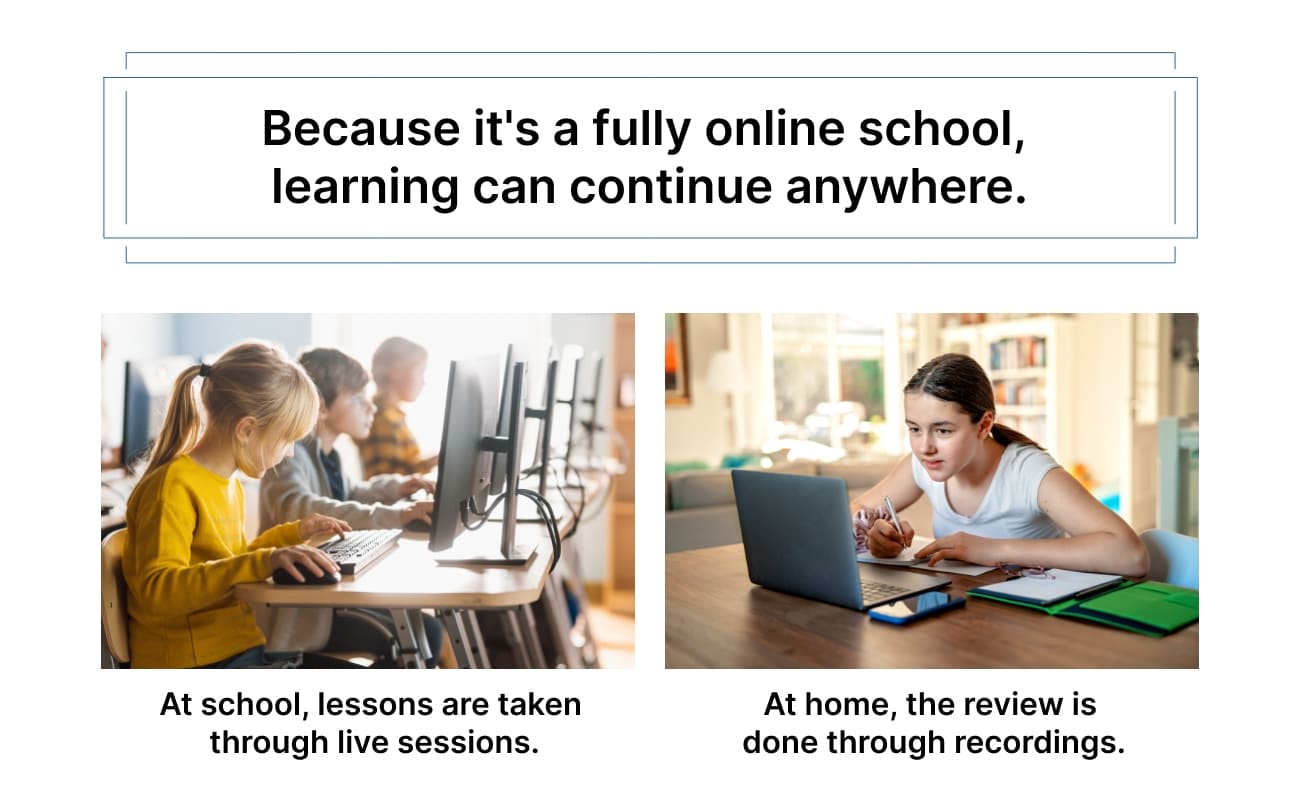
Instructors can track students' current proficiency and attendance rates.
It has been challenging for instructors to grasp students' Japanese language acquisition. Moreover, just because someone is a school teacher doesn't mean they can teach Japanese as a second language, so many teachers struggle with this barrier. Since Nisai is a fully online school, instructors can easily monitor students' attendance rates, assignment status, and overall learning progress. With feedback from Nisai instructors available, instructors can also devise ways to communicate with and support students effectively.
Instructors can monitor students' assignment status.

Instructors can also track students' attendance status.

Nisai will become a member of your school's Japanese instruction team.
Many teachers and administrators may think, "We know this student needs Japanese language education, but we don't have the time," "We don't have teachers who can teach Japanese as a second language," or "We want to arrange it, but we can't find anyone." Since classes in schools are conducted in Japanese, it's essential to acquire language skills for effective communication and knowledge transfer. However, arranging teachers who can teach Japanese and setting aside learning time can be challenging. With Nisai as your school's Japanese education partner, there's no need to go through the hassle of arranging Japanese language teachers or creating learning environments and schedules.

Fully online learning allows for simultaneous participation from multiple locations.
Organizations with schools spread across a wide area used to have to arrange Japanese language teachers for each school. However, since Nisai is an online school, classrooms exist online as well. Students can participate from anywhere. This means that regardless of location, students can attend classes from multiple schools simultaneously.
There has been an increase in students transferring from overseas to schools in Japan. One of the issues faced by Japanese schools is providing Japanese language instruction to non-Japanese-speaking students. Typically, this responsibility falls on the teachers at the school, but with busy schedules, it's practically difficult to allocate time specifically for Japanese language instruction for these students. Leveraging the fully online nature of Nisai, we can provide Japanese language education even within the school's curriculum hours. There's no need for schools to arrange separate Japanese language instructors. We will conduct Japanese language education entirely online. This can reduce the burden on teachers at the school and ensure that students don't miss out on learning opportunities. Let's cultivate Japanese language proficiency while attending Nisai's CEFR courses.
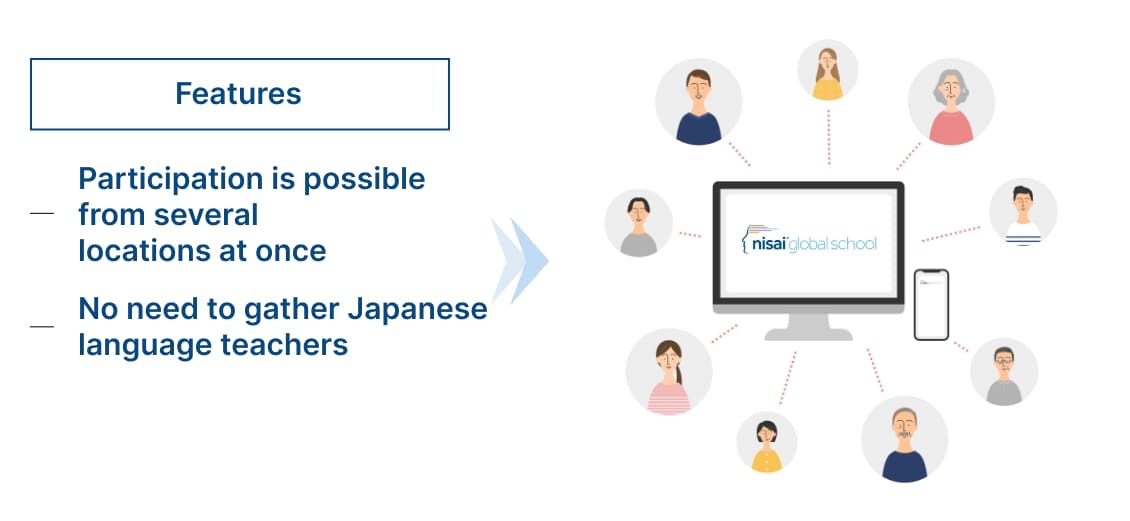
Program and Learning Content of the CEFR Japanese Course
Based on the results of the assessment check test, students will be divided into beginner (N5, N4), intermediate (N3, N2), and advanced (N1) level classes. The assessment check test is conducted to determine your current Japanese language proficiency.
Beginner Program Example of learning content
Example: The learning content for CEFR A1
| Week Number | Unit | Topic |
|---|---|---|
| 1 | 1. Assessment | 1. Initial Assessment |
| 2 | 2. Speaking and Listening | 1. My Life |
| 3 | ||
| 4 | 2. My Likes and Dislikes | |
| 5 | ||
| 6 | 3. At Home and School | |
| 7 | ||
| 8 | 3. Reading | 1. Sentences |
| 9 | ||
| 10 | 2. Audience | |
| 11 | ||
| 12 | 3. Comprehension | |
| 13 | ||
| 14 | 4. Purpose | |
| 15 | ||
| 16 | 4. Grammar | 1. Nouns |
| 17 | ||
| 18 | 2. Verbs | |
| 19 | ||
| 20 | 3. Adjectives | |
| 21 | ||
| 22 | 4. Adverbs | |
| 23 | ||
| 24 | 5. Tenses | |
| 25 | ||
| 26 | 6. Punctuation | |
| 27 | ||
| 28 | 5. Writing | 1. Forms |
| 29 | ||
| 30 | ||
| 31 | 2. Description | |
| 32 | ||
| 33 | ||
| 34 | ||
| 35 | 1. Assessment | 2. Final Assessment |
Intermediate and advanced programs are also designed to develop language skills.
- Elementary - CEFR A1 and A2 levels
- Intermediate - CEFR B1 and B2 levels
- Advanced - CEFR C1 and C2 levels
Skills and abilities acquired through the CEFR Japanese Course
(Target: Elementary school students to adults)
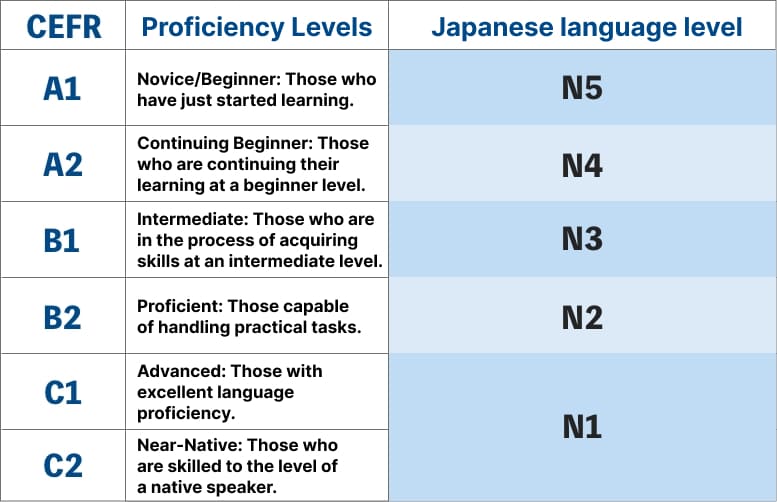
Beginner Program
CEFR A1 to A2 course
|
A1 |
A2 |
Upper A1 | Can use and understand basic greetings and short conversations. | Understand what one should do from instructions or simple emails and respond appropriately. | Can understand common words and expressions used in daily life and engage in simple exchanges with others. |
As indicated above, at the A1 level (from N5 to lower N4), students will develop skills for basic greetings, short conversations, and simple exchanges with others, while at the A2 level (from upper N4 to lower N3), they will develop skills to respond appropriately to instructions or simple emails.
Intermediate Program
CEFR B1 to B2 course
|
B1 |
B2 |
| Acquire expressions and ways for problem-solving, such as dealing with troubles, and can actively take action. | Can engage in conversations in various daily situations using appropriate business manners accordingly. |
As indicated above, at the B1 level, students will acquire expressions for problem-solving and take proactive actions. At the B2 level, they will be able to engage in conversations using appropriate business manners based on the situation. Here, students can also understand specialized terms necessary for work.
Advanced Program
CEFR C1 to C2 course
|
C1~C2 |
| Can smoothly conduct negotiations and presentations that require communication skills. |
As indicated above, at the C1 to C2 level, students will be able to smoothly conduct negotiations and presentations requiring communication skills.
Schedule of the CEFR Japanese Course
- Four live lessons of 30 minutes each per week (35-week program for approximately 9 months)
※Weekly live lessons of 40 minutes three times a week, or 60 minutes twice a week, are also available
Tuition and Fees
- CEFR Japanese Course
For individuals
Monthly fee: ¥18,150(tax included)
※The same amount applies for three times a week or twice a week.
In addition, there is an membership fee of ¥33,000 (tax included) at the time of enrollment. (First time only)
For companies
Please contact us for a quote after a hearing session.
Message

Nisai CEO: Dhruv Patel
As the representative of the Nisai Group, I have been delivering student-centered education for over 20 years. Education should always be student-centered, and it is our responsibility as educators to deliver education tailored to individual needs.
We began by providing education for students who could no longer attend school due to illness, disability, bullying, or family circumstances in the UK's compulsory education system. Our teachers and staff engage with students with the motto of ensuring that students have solid opportunities and choices for their future.
About Nisai
In international schools in Japan, you often hear the term "WASC accredited school." WASC stands for the Western Association of Schools and Colleges, an organization headquartered in California, USA. It certifies schools from kindergarten to 12th grade (equivalent to high school senior year) and universities.
Nisai's courses are accredited by OCR and Cambridge. OCR stands for Oxford, Cambridge, and the Royal Society of Arts. We have received accreditation from reputable institutions in the UK. Additionally, as the first online school to be recognized as a Cambridge International School, Nisai has received accreditation.
All courses are taught by experienced native teachers. Even students who currently lack confidence in English can develop their skills efficiently with lessons tailored to their current English proficiency level.
Our CEFR Japanese course leverages 26 years of online education expertise and techniques, providing high-quality education by experienced Japanese instructors.
This course focuses on improving Japanese language skills in listening, reading, writing, and speaking, with learning content based on real situations related to public, personal, educational, and professional topics.
Each course is designed to strengthen learners' Japanese language proficiency according to their desired level of proficiency. At Nisai, you can learn from N5 level to N2 level.
Lessons in the CEFR Japanese course have the following characteristics:
- Questions are used as formative assessments.
- Lessons are tailored based on learners' current proficiency levels.
- Opportunities for interactive conversations are provided in online classrooms.
- Students can answer either by speaking or typing in the chat.
- Answers are shared among groups.
- Opportunities for group work are provided.
- Breakout rooms are used to facilitate small group work.
- Students are encouraged to form their own ideas.
- Opportunities are provided to present ideas to a wider group.
- Exercises are used in lessons to apply what has been learned to support learning.
- Exercises are both enjoyable and productive.
- Students can use tools within the online classroom to emphasize their answers.
- Permissions provide a controlled environment for learning.
- Activities are designed for everyone to participate.
